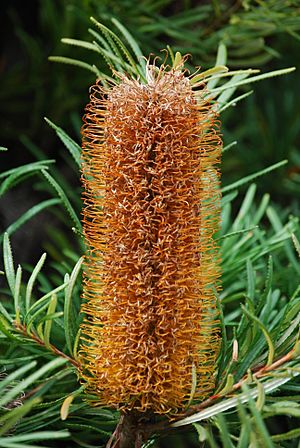Banksia spinulosa var. spinulosa facts for kids
Quick facts for kids Banksia spinulosa var. spinulosa |
|
|---|---|
 |
|
| Scientific classification |
|
| Kingdom: | Plantae |
| Clade: | Tracheophytes |
| Clade: | Angiosperms |
| Clade: | Eudicots |
| Order: | Proteales |
| Family: | Proteaceae |
| Genus: | Banksia |
| Species: | |
| Varietas: |
B. s. var. spinulosa
|
| Trinomial name | |
| Banksia spinulosa var. spinulosa |
|
Banksia spinulosa var. spinulosa is a type of shrub that grows along the eastern coast of Australia. You can find it in Queensland and New South Wales. It's a special kind of plant that belongs to the larger Banksia spinulosa family, also known as the Hairpin Banksia.
Contents
What Does It Look Like?
Like other types of Hairpin Banksia, Banksia spinulosa var. spinulosa is a shrub with many stems. It has a special woody swelling at its base called a lignotuber. This helps the plant regrow if it gets damaged, for example, by fire.
Its flowers grow in spikes that are usually golden. Some spikes might have red or purple parts. You can tell this plant apart from other types of Hairpin Banksia by its leaves. Its leaves have edges that curl strongly backwards, which is called revolute. Also, its leaves are narrower and have small teeth only near their tips.
This plant is also different from Banksia spinulosa var. cunninghamii because it has a lignotuber and many stems.
How Scientists Classify It
Naming the Plant
Scientists use a system called taxonomy to name and group living things. Banksia spinulosa var. spinulosa is the original type of the Banksia spinulosa species. This means it's the plant that scientists first used to describe the whole species.
A surgeon named John White likely collected this plant in 1792. The next year, a scientist named Smith officially described it. He gave it the name "spinulosa," which is a Latin word meaning having tiny spines. This probably refers to the small points on the leaf tips.
How Its Classification Changed
Over time, scientists have changed how they group Banksia spinulosa var. spinulosa with other plants. Here's a quick look at some of those changes:
- In 1830, Robert Brown placed Banksia spinulosa in a group he called "True Banksias."
- In 1870, George Bentham grouped all Banksia species with hooked styles (parts of the flower) together. This arrangement lasted for over 100 years.
- In 1981, Alex George published a new way to classify Banksia plants. He made Banksia collina and Banksia cunninghamii into varieties of Banksia spinulosa. This is when the name Banksia spinulosa var. spinulosa was first used.
- Later, in 1996, Kevin Thiele and Pauline Ladiges suggested another arrangement based on cladistics. This is a method that groups organisms by how closely they are related through evolution.
- In 1999, Alex George went back to his 1981 classification system.
Current Classification
Under Alex George's current system, Banksia spinulosa var. spinulosa fits into the plant family tree like this:
- Genus Banksia
- Subgenus Banksia
- Section Oncostylis
- Series Spicigerae
- Section Oncostylis
- Subgenus Banksia
* B. spinulosa ** B. spinulosa var. spinulosa ** B. spinulosa var. collina ** B. spinulosa var. neoanglica ** B. spinulosa var. cunninghamii * B. ericifolia * B. verticillata * B. seminuda * B. littoralis * B. occidentalis * B. brownii
Scientists like Austin Mast are still studying Banksia plants using DNA to understand their relationships better.
Other Names for This Plant
This plant has two other scientific names that are no longer commonly used:
- Banksia incognita (published in 1798)
- Banksia denticulata (published in 1814)
Where It Lives
This plant grows in different areas along the east coast of Australia. It is most common in New South Wales, from the border with Victoria up to Newcastle.
You can also find smaller, separate groups of these plants in Queensland. These include areas near Gympie, between Coral Bay and Gladstone, and inland on the Blackdown Tableland. There are also some in northern Queensland, between Mossman and Ravenshoe.
It usually grows in sandy soil, both near the coast and in inland mountains. You'll often see it as a smaller shrub under taller Eucalyptus trees in open forests and woodlands.
Growing It in Your Garden
This type of Banksia is a popular plant for gardens in eastern Australia. It can grow in many different conditions. How it grows can depend a lot on where the seeds came from and the conditions it's grown in.
Generally, it grows slowly. It can take up to eight years for a plant grown from seed to flower for the first time. It can handle strong pruning, meaning you can cut it back a lot. Even if you cut it right down to the ground, it will usually grow back from its lignotuber. It can also survive cold temperatures, down to about -8°C (17.6°F). It likes sunny or partly shady spots and soil that drains well.
Images for kids
-
Banksia spinulosa (yellow styles), Georges River National Park (near Sydney)
-
Near Nowra, NSW. May 2005
-
Wollstonecraft. April 2007





